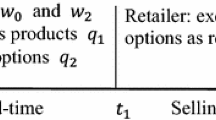Abstract
If an exporter or a wholesaler sells goods at a fixed price to be paid in the currency of the seller’s country, then the purchase price of the importer depends upon the prevailing exchange rate of their respective currencies. Ideally, in a floating exchange rate system, the purchase price has to change according to shifts in the exchange rate. In such a scenario the entire exchange rate risk is borne by the importer/buyer. However, in international trade, it is customary for the parties to enter into a risk-sharing agreement, under which the buyer does not pay the seller on the basis of the prevailing exchange rate, but pays a mutually agreed upon price that falls within a range of fluctuating exchange rates. In this manner, the profit or loss due to fluctuations in the exchange rate would be shared by both the parties. These stochastic variations in purchase prices are modeled through a Markov chain. In this article, the resulting purchase and inventory problem is analyzed by identifying a regenerative cycle. An optimal selling price that maximizes the expected profit per unit time is also discussed. Further, optimal ordering policies under no stock-out conditions are derived with an optimal uniform demand corresponding to the optimal selling price. Through sensitivity analyses, differences in profit function with respect to carrying cost fraction, setup costs, and purchase prices are also shown. An investigation into the possible loss if this model solution is not implemented is also made through numerical illustrations. A discussion of a special case of two-purchase price scenario gives additional insight into the problem.



Similar content being viewed by others
References
Moffett, M.H., Stonehill, A.I., Eiteman, D.K.: Fundamentals of Multinational Finance, 6th edn. NY Pearson, New York (2018)
Kim, K.K., Park, K.S.: Transferring and sharing exchange-rate risk in a risk-averse supply chain of a multinational firm. Eur. J. Oper. Res. 237(2), 634–648 (2014)
Naddor, E.: Inventory Systems. Wiley, New York (1966)
Goyal, S.K.: An inventory model for a product for which price fluctuates. Oper. Res. 3(2), 112–117 (1975)
Buzacott, J.A.: Economic order quantities with inflation. Oper. Res. Q. 26(3), 553–558 (1975)
Lev, B., Soyster, A.L.: An inventory model with finite horizon and price changes. J. Oper. Res. Soc. 30(1), 43–53 (1979)
Goyal, S.K.: A note on the paper: an inventory model with finite horizon and price changes. J. Oper. Res. Soc. 30(9), 839–840 (1980)
Taylor, S.G., Bradley, C.E.: Optimal ordering strategies for announced price increases. Oper. Res. 33(2), 312–325 (1985)
Lev, B., Weiss, H.J.: Inventory models with cost changes. Oper. Res. 38(1), 53–63 (1990)
Gascon, A.: On the finite horizon EOQ model with cost changes. Oper. Res. 43(4), 716–717 (1995)
Ghosh, A.K.: On some inventory models involving shortages under an announced. Int. J. Syst. Sci. 34(2), 129–137 (2003)
Huang, W., Kulkarni, V.G.: Optimal EOQ for announced price increases in infinite horizon. Oper. Res. 51(2), 336–339 (2003)
Taleizadeh, A.A., Pentico, D.W.: An economic order quantity model with a known price increase and partial backordering. Eur. J. Oper. Res. 228(3), 516–525 (2013)
Arcelus, F.J., Pakkala, T.P.M., Srinivasan, G.: On the interaction between retailer’s inventory policies and manufacturer trade deals in response to supply-uncertainty occurrences. Ann. Oper. Res. 143, 45–58 (2006)
Arcelus, F.J., Pakkala, T.P.M., Srinivasan, G.: A retailer’s decision process when anticipating a vendor’s temporary discount offer. Comput. Ind. Eng. 57, 253–260 (2009)
Arcelus, F.J., Pakkala, T.P.M., Srinivasan, G.: A purchasing framework for B2B pricing decisions and risk-sharing in supply chains. J. Decis. Sci. Inst. 33(4), 645–672 (2002)
Pegels, C.C., Jelmert, A.E.: An evaluation of blood-inventory policies: a Markov chain application. Oper. Res. 18(6), 1087–1098 (1970)
Arcelus, F.J., Pakkala, T.P.M., Srinivasan, G.: Retailer’s response to repetitive special sales under uncertainty. Int. J. Quant. Prod. Manag. 6, 137–149 (2000)
Abboud, N.E.: A discrete-time Markov production-inventory model with machine breakdowns. Comput. Eng. 39, 95–107 (2001)
Chen, F., Song, J.S.: Optimal policies for multiechelon inventory problems with Markov—modulated demand. Oper. Res. 49(2), 226–234 (2001)
Hekimoglu, M., van der Laan, E., Dekker, R.: Markov-modulated analysis of a spare parts system with random lead times and disruption risks. Eur. J. Oper. Res. 269(3), 909–922 (2018)
Emmons, H., Gilbert, S.M.: The role of returns policies in pricing and inventory decisions for catalogue goods. Manag. Sci. 44, 276–283 (1998)
Lau, A.H.L., Lau, H.S.: Effects of a demand-curve’s shape on the optimal solutions of a multi-echelon inventory/pricing model. Eur. J. Oper. Res. 147, 530–548 (2003)
Lau, A.H.L., Lau, H.S.: Some two-echelon supply-chain games: improving from deterministic-symmetric-information to stochastic-asymmetric-information models. Eur. J. Oper. Res. 161(1), 203–223 (2005)
Petruzzi, N.C., Dada, M.: Pricing and the newsvendor problem: a review with extensions. Oper. Res. 47(2), 183–194 (1999)
Weng, Z.K.: Modeling quantity discounts under general price-sensitive demand functions: optimal policies and relationships. Eur. J. Oper. Res. 86, 300–314 (1995)
Ross, S.: Stochastic Processes. Wiley, New York (1983)
Author information
Authors and Affiliations
Corresponding author
Additional information
Publisher's Note
Springer Nature remains neutral with regard to jurisdictional claims in published maps and institutional affiliations.
Rights and permissions
About this article
Cite this article
Kharvi, S., Pakkala, T.P.M. & Srinivasan, G. Ordering policies under currency risk sharing agreements: a Markov chain approach. OPSEARCH 56, 945–964 (2019). https://doi.org/10.1007/s12597-019-00394-z
Accepted:
Published:
Issue Date:
DOI: https://doi.org/10.1007/s12597-019-00394-z




